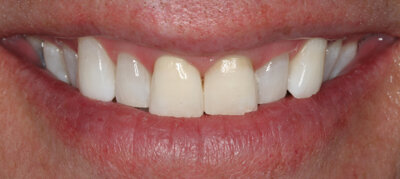People generally think of teeth as being white. But tooth enamel can be many different shades. Over time, tooth enamel can change color or become stained. There are many reasons why teeth become discolored:
genetics—tooth color can run in the family
aging
injury to the teeth
illness
medicines, such as some antibiotics
tobacco use
contact with stain-causing food and drinks over time (such as berries, sauces, coffee, cola, black tea, and red wine)
getting too much fluoride while teeth are developing
If your teeth are discolored, tooth whitening may help. “Whitening” is any process that can make teeth look whiter. It may be safely done at home or in a dental office.
Options for whitening your teeth
Tooth-whitening options range from gentle surface whiteners to stronger ones that can also remove deeper stains. There are many different types of tooth whitening products. They fall into three main types:
Whitening toothpastes help remove stains on the surface of your teeth. They are the gentlest kind of whiteners. Since they work using polishing action rather than chemicals, they usually do not have side effects. However, they do not get teeth as white as chemical products. Whitening toothpastes can lighten teeth a little bit at a time, over days or weeks.
Whitening toothpastes can be bought over the counter. Several whitening toothpastes have earned the American Dental Association’s (ADA’s) Seal of Acceptance.
Home-use whiteners come from your dentist or are sold over the counter. They can be applied with trays, strips, a rinse, or a brush. They usually contain a chemical called peroxide, which gets below the surface to lighten tooth enamel. Home-use whiteners are meant to be used over days or weeks. It is best to consult your dentist before whitening your teeth.
Your dentist may make special whitening trays for your upper and lower teeth. You put the whitening gel in the trays and wear them for short times during the day or overnight. Your dentist will tell you how long to wear them. If you wear the trays for too long, the peroxide in the gel can irritate your teeth.
In-office whitening is done in the dental office. In-office whiteners are much stronger than whitening toothpastes and home-use whiteners, since they have more peroxide. They can change the color of your teeth faster than the other methods.
The in-office whitening is usually done in about one hour. To help protect the mouth from the peroxide, the patient’s gum tissues are covered either with a thin sheet of rubber or a protective gel. Sometimes a light or laser is used with the peroxide.
Before in-office whitening
After in-office whitening
Side effects
For a few days after treatment, your teeth may be sensitive to very hot or cold temperatures. Whitening may also irritate the gums for a short time. If the side effects do not go away after a few days, see your dentist.
To avoid harming your teeth and gums, always follow the product directions and any instructions from your dentist. If your teeth become very sensitive or you get sores in your mouth, stop using in-home products and call your dentist.
There is such a thing as too much whitening. Do not use whitening products for longer than advised in the product directions or by your dentist. Over-whitening can cause severe discomfort to your teeth and gums. Too much whitening can even harm your tooth enamel.
It’s not for everyone
Tooth whitening is not a good choice for all people. If your gums have pulled away from the teeth in some places, whitening may irritate these areas. If you have tooth decay or gum disease, your dentist may recommend that these be treated before whitening. Also, the color of fillings, crowns, and some stains cannot be changed by tooth whitening.
So talk to your dentist about tooth whitening before you begin. He or she will do an oral exam to find out if tooth whitening is right for you.
Keep your teeth white
Newly whitened teeth may stain more easily. To keep your teeth white as long as possible, avoid tobacco and stain-causing food and drinks for several days after whitening. Keep in mind that teeth usually return to their original shade over time. But if you steer clear of tobacco and large amounts of stain-causing food and drinks, your teeth may stay bright for several years.
Before-and-after whitening photos courtesy of Dr. Victor H. Burdick.
Scheduling
Request an appointment and one of our staff will call you to help you schedule your appointment.
Our Location
1700 Broad Street, Suite 130
Chattanooga, TN 37408
423-265-3471
Questions?
Find answers and learn more about dental problems and treatments in our digital library.



